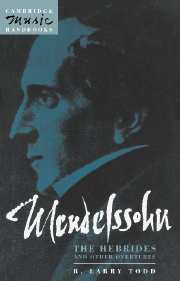4 - Formal considerations: a synoptic overview
Published online by Cambridge University Press: 23 November 2009
Summary
Mendelssohn founded all three overtures upon the traditional principles of sonata form, yet in each case he modified the structural plan to fit the programmatic requirements of the specific subject-matter, as if to permit the extra-musical elements to vie with formal considerations. This is an approach he pursued in other overtures, for example to the cantata Die erste Walpurgisnacht (Op. 60, 1832, revised 1843), with its graphic interruption of the formal process to depict the transition from winter to spring, and Die schöne Melusine (Op. 32, 1833), with its alternating materials in the tonic major and minor for the water nymph and her knight-husband, so that the music tends toward a sonata-rondo design. Now Mendelssohn is usually not thought to be numbered among those ‘progressive’ nineteenth-century composers who advanced the cause of programme music – this was the composer, as Hector Berlioz put it, who studied the music of the dead too closely – yet, in a curious way, his testing of Marx's ‘characteristic music’ in the concert overture during the 1820s anticipated Franz Liszt's comment to Louis Köhler in 1856: ‘I only beg for permission to be allowed to decide upon the forms by the contents … In the end it comes principally to this – what the ideas are, and how they are carried out and worked up – and that leads us always back to the feeling and invention, if we would not scramble and struggle in the rut of a mere trade.’
A second distinguishing feature of the three overtures – their use of interrelated networks of motivic complexes – also marks these works as among Mendelssohn's most progressive efforts.
- Type
- Chapter
- Information
- Mendelssohn: The Hebrides and Other Overtures , pp. 52 - 68Publisher: Cambridge University PressPrint publication year: 1993



